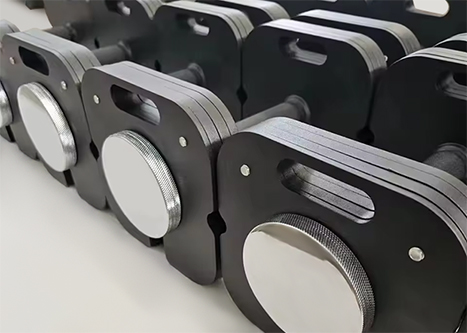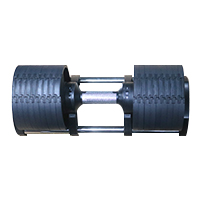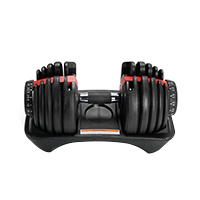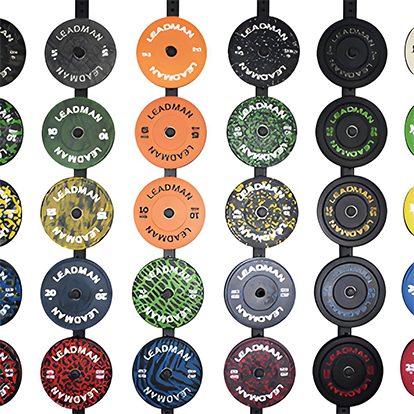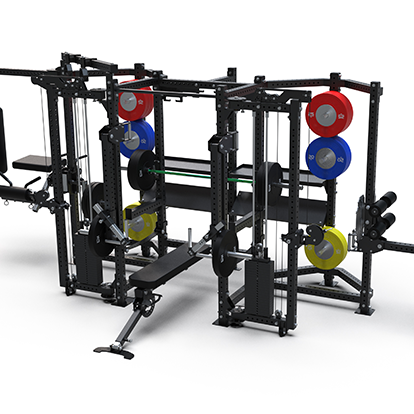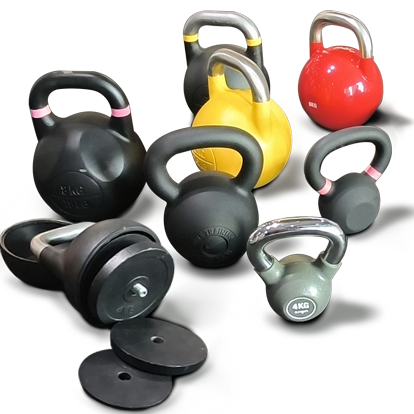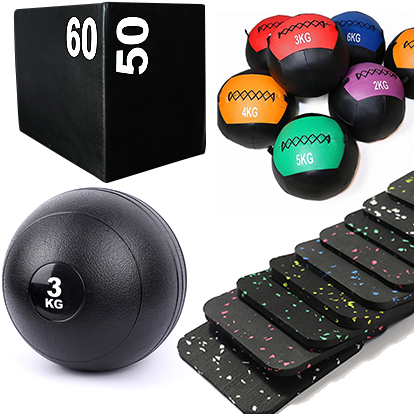Dumbbells
Home / Dumbbells
Purchase Best Dumbbells and Sets | Leadman Fitness
At Leadman Fitness, we provide a diverse selection of high-quality dumbbells crafted for durability, performance, and user comfort. Our hexagonal dumbbells are constructed from natural rubber, making them environmentally friendly and odorless, while featuring a smooth finish that feels great in hand. The unique hexagonal design enhances stability during workouts, making them ideal for commercial gym settings. Each dumbbell comes with chrome-plated steel handles that ensure a solid and comfortable grip. The handles are expertly welded to the ends, eliminating any gaps or seams to greatly enhance safety during use. Manufactured with precision, our dumbbells maintain a weight tolerance of ±3%, ensuring reliability in every workout.
We offer a variety of types to suit different training needs, including hex dumbbells available in pairs ranging from 2.5LB to 125LB (2.5KG to 60KG). The rubber-coated ends minimize noise and reduce floor damage, making them perfect for gyms. Our PVC-coated dumbbells are made from durable PVC material, which withstands wear and tear while featuring a sleek, easy-to-clean finish. For those looking for environmentally friendly options, our TPU round dumbbells come in various colors and have a smooth surface that resists fading and chipping, ensuring quiet use. Additionally, our adjustable dumbbells are designed to save space and money, featuring a sturdy ductile iron base and a long handle for enhanced safety and stability.
We also offer specialized designs such as CPU-coated dumbbells and custom logo options for branding. All our products prioritize environmental safety, ensuring they are odorless, elastic, and highly durable against impact. Each dumbbell is individually packaged with fragile labels for safe transport. Our products are perfect for all fitness levels and are essential for strength training, allowing for a wide range of exercises that target different muscle groups. Dumbbells facilitate unilateral training to correct muscle imbalances and engage smaller stabilizing muscles, enhancing joint stability and functional strength. Explore our collection of dumbbells, and bring the gym experience with Leadman Fitness. Elevate your strength training routine today! Leadman Fitness dumbbells correct imbalances, strengthen stabilizers, and come in adjustable, rubber-coated hex, or polyurethane sets or pairs.
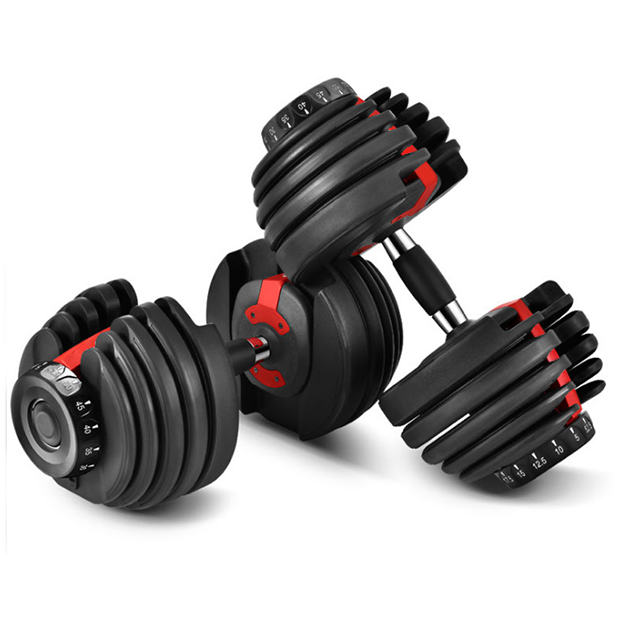
Leadman Fitness’s Popular Products About Dumbbells
Purchase Dumbbells Set
What is a Dumbbell Set?
A dumbbell set typically consists of two or more dumbbells of varying weights, designed to provide users with a range of resistance options for strength training. These sets often come in a variety of formats, including fixed-weight dumbbells and adjustable models, allowing users to select the appropriate weight for different exercises and fitness levels.
Benefits of Having a Dumbbell Set:
Progressive Training: Having a range of weights enables users to progressively overload their muscles. As strength improves, individuals can increase the weight they lift, facilitating muscle growth and strength development. For example, a beginner might start with lighter weights (like 5 or 10 lbs) and gradually progress to heavier weights (like 15 or 20 lbs) as they build strength.
Versatility in Exercises: A complete dumbbell set allows for a wide variety of exercises targeting multiple muscle groups. Users can perform traditional strength exercises such as bicep curls and shoulder presses, as well as compound movements like dumbbell squats and lunges. This versatility makes dumbbells suitable for full-body workouts, enhancing overall fitness.
Space Efficiency: Dumbbell sets, particularly those that are adjustable or come in a compact design, can be easily stored in small spaces, making them ideal for gyms. Unlike larger weightlifting equipment, dumbbells require minimal floor space and can be easily stacked or placed on shelves.
Considerations When Purchasing a Dumbbell Set
Material: Look for durable materials that can withstand regular use. Common materials include cast iron, rubber-coated, or neoprene. Rubber coated dumbbell sets tend to be more protective for floors, while cast iron offers sturdiness.
Weight Options: Assess your current fitness level and training goals. If you’re a beginner, starting with lighter weights may be advisable. For more advanced training, consider sets that offer a higher maximum weight or adjustable weights for versatility. A medium dumbbell set is a great option for individuals who have surpassed the beginner stage but are not yet at an advanced level. It typically includes a range of moderate weights that allow for progression without overwhelming the user.
Storage Solutions: Consider how much space you have available. If storage is limited, adjustable dumbbells or compact sets can save space. Some sets come with stands or racks, making organization easier and helping to maintain a tidy workout area.
Budget: Dumbbell sets can vary widely in price. Fixed-weight sets are generally less expensive than adjustable ones, so determine your budget and find a set that fits within it while still meeting your quality standards.
Adjustable Dumbbells
Features of Adjustable Dumbbells
How Adjustable Dumbbells Work:
Adjustable dumbbells consist of a handle with a set of weight plates that can be added or removed to change the total weight. These plates can often include Olympic weight plates, which are designed with a larger diameter and a 2-inch hole to fit Olympic bars. Typically, the user can select the desired weight by adjusting a dial, pin, or lever mechanism, which locks the selected plates onto the handle. This design allows users to quickly switch weights without the need for multiple separate dumbbells, making workouts more efficient.
Advantages of Using Adjustable Dumbbells:
Space-Saving: One of the primary benefits of adjustable dumbbells is their ability to replace multiple sets of fixed-weight dumbbells. This feature is especially advantageous for those with limited space in gyms, as adjustable dumbbells can easily fit into a small storage area.
Cost-Effectiveness: While the initial investment may be higher than that of fixed-weight dumbbells, adjustable dumbbells can save money over time by providing multiple weight options in one product. They eliminate the need to purchase separate dumbbells of varying weights.
Versatility: Adjustable dumbbells cater to users of all fitness levels, from beginners to advanced lifters. The ability to change weights quickly allows for a wide range of exercises, accommodating different workout goals and routines.
Locking Mechanisms:
Most adjustable dumbbells utilize various locking mechanisms to ensure the weight plates remain securely attached during use. Common types include:
Dial Systems: Users can turn a dial to select the desired weight, which automatically adjusts the weight plates attached to the handle.
Pin Systems: Users can insert a pin to lock specific weight plates in place, allowing for quick adjustments.
Lever Systems: Users lift a lever to select weight plates, which engage with the handle when lowered back down.
Best Adjustable Dumbbells on the Market
Leadman Fitness is dedicated to providing high-quality fitness products designed to meet the diverse needs of fitness enthusiasts. Among their standout offerings are adjustable dumbbells, which epitomize the brand’s commitment to innovation, versatility, and user-centric design.
Space-Saving Solutions
One of the primary advantages of Leadman Fitness’s adjustable dumbbells is their space-saving design. These versatile weights replace multiple sets of fixed-weight dumbbells, making them an ideal choice for users with limited space, such as those setting up smaller workout areas. With Leadman Fitness’s adjustable dumbbells, users can easily store their equipment in compact spaces, keeping their workout area organized and clutter-free.
Cost-Effectiveness
Leadman Fitness recognizes the financial concerns of fitness enthusiasts, which is why their adjustable dumbbells are designed to be cost-effective. While the initial investment may be higher than traditional fixed-weight options, these adjustable dumbbells save money over time by offering multiple weight options in a single product. This eliminates the need for purchasing separate dumbbells of varying weights, making it a smart choice for budget-conscious fitness aficionados.
Versatility for All Fitness Levels
Leadman Fitness’s adjustable dumbbells cater to users of all fitness levels, from beginners embarking on their fitness journey to advanced lifters seeking to challenge themselves. The design allows for quick and easy weight adjustments, enabling users to switch weights seamlessly between exercises. This versatility accommodates a wide range of workout goals, from strength training and bodybuilding to rehabilitation and endurance workouts.
Commitment to Quality
In addition to the benefits of space-saving, cost-effectiveness, and versatility, Leadman Fitness prioritizes quality in its products. Each adjustable dumbbell is constructed with durable materials to ensure safety and longevity, providing users with reliable equipment that can withstand rigorous training sessions.
Considerations for Selecting Adjustable Dumbbells:
Price: Adjustable dumbbells can range widely in price. While more expensive models may offer advanced features, it’s essential to balance your budget with the features that are most important to you.
Quality: Look for durable materials and construction. High-quality adjustable dumbbells are typically made from robust metals with a solid locking mechanism to ensure safety during workouts.
User Reviews: Reading user reviews can provide insights into real-world performance and reliability. Look for products with high ratings and positive feedback regarding ease of use, durability, and effectiveness.
Weight Range: Consider your current fitness level and future goals when selecting adjustable dumbbells. Ensure the weight range accommodates your needs, allowing for progression in your training.
Warranty: Check if the manufacturer offers a warranty. A good warranty can indicate the manufacturer’s confidence in their product and provide peace of mind for your purchase.
Dumbbell Exercises
Effective Dumbbell Exercises for Beginners
For those new to strength training, dumbbells provide a fantastic way to build foundational strength, improve muscle tone, and enhance overall fitness. Here are some effective exercises that beginners can easily incorporate into their routines:
Dumbbell Curls
Overview: This classic exercise targets the biceps and is excellent for building arm strength.
Execution: Stand with your feet shoulder-width apart, holding a dumbbell in each hand at your sides. Keep your elbows close to your torso and curl the weights up towards your shoulders, then lower them back down with control.
Tips for Proper Form:
Keep your back straight and avoid swinging your body to lift the weights.
Focus on isolating the biceps by keeping your elbows stationary.
Dumbbell Shoulder Press
Overview: This exercise strengthens the shoulders and upper arms.
Execution: Sit or stand with a dumbbell in each hand at shoulder height. Press the weights overhead until your arms are fully extended, then lower them back to the starting position.
Tips for Proper Form:
Engage your core to maintain stability throughout the movement.
Ensure that your wrists are straight and aligned with your elbows to prevent strain.
Goblet Squats
Overview: Goblet squats are a fantastic lower-body exercise that also engages the core.
Execution: Hold a dumbbell close to your chest with both hands, keeping your elbows pointed down. Stand with your feet slightly wider than shoulder-width apart. Lower your body into a squat, ensuring your knees do not extend past your toes, then return to standing.
Tips for Proper Form:
Keep your chest lifted and back straight during the squat.
Focus on driving through your heels as you rise back up.
Advanced Dumbbell Workouts
Once you’ve mastered the basics, you can progress to more complex exercises that challenge your strength and coordination. Here are some advanced dumbbell workouts to consider:
Dumbbell Snatches
Overview: This explosive movement works the entire body, focusing on power and coordination.
Execution: Start with the dumbbell on the ground between your feet. In one fluid motion, lift the dumbbell overhead, transitioning from a squat to standing. Reverse the motion to return to the starting position.
Tips for Proper Form:
Keep your core engaged throughout the movement to maintain stability.
Ensure that you drive through your legs to generate power and lift the weight efficiently.
Renegade Rows
Overview: This exercise targets the back, shoulders, and core while also engaging the stabilizer muscles.
Execution: Start in a plank position with a dumbbell in each hand. Row one dumbbell towards your hip while balancing on the opposite arm and feet. Alternate sides.
Tips for Proper Form:
Keep your body in a straight line from head to heels to maintain core engagement.
Avoid twisting your hips as you row the dumbbell; instead, stabilize your core.
Dumbbell Thrusters
Overview: This compound movement combines a squat and an overhead press, making it a full-body workout.
Execution: Hold the dumbbells at shoulder height. Perform a squat, and as you rise, press the dumbbells overhead until your arms are fully extended. Lower the weights back to shoulder height as you descend into the next squat.
Tips for Proper Form:
Keep your chest up and back straight throughout the squat.
Coordinate your movements; drive through your legs to gain momentum for the overhead press.
Structuring a Full-Body Dumbbell Workout Routine
For a well-rounded workout routine using dumbbells, consider structuring your session as follows:
Warm-Up: Begin with a 5-10 minute warm-up, including dynamic stretches and light cardio to prepare your muscles.
Circuit Training: Combine exercises into circuits that target different muscle groups. For example:
Circuit 1: Dumbbell curls, goblet squats, and shoulder presses (repeat for 3 sets).
Circuit 2: Dumbbell snatches, renegade rows, and thrusters (repeat for 3 sets).
Cool Down: Finish with stretching to promote flexibility and aid recovery.
Frequency: Aim for at least 2-3 dumbbell workout sessions per week, allowing for rest days in between to ensure muscle recovery.
Dumbbells 10 lbs
Leadman FitnessBenefits of 10 lbs Dumbbells
Suitability for Beginners:
- Ease of Use: 10 lbs dumbbells are light enough for those new to strength training, allowing for proper technique without overwhelming the user.
- Building Confidence: Starting with a manageable weight helps beginners gain confidence and develop a foundational strength base.
Ideal for Rehabilitation and Toning:
- Rehabilitation: Discuss how 10 lbs dumbbells can aid in physical therapy by allowing for gradual strength building post-injury. Exercises can be adjusted in intensity to match the rehabilitation progress.
- Toning: Explain how light weights can be effectively used for toning muscles without bulking up, making them suitable for those looking to enhance muscle definition.
Versatility in Workouts:
Highlight how 10 lbs dumbbells can be integrated into various fitness routines, including strength training, circuit training, and functional fitness, making them a versatile addition to any gym.
Lateral Raises: Tricep Extensions: Recommend maintaining a straight posture and avoiding back strain. Bicep Curls:Recommended Exercises with 10 lbs Dumbbells
Effective Exercises:
Suggest performing 3 sets of 10-15 repetitions.
Lunges:Tips for Ensuring Proper Form:
The Benefits of Using Dumbbells for Strength Training
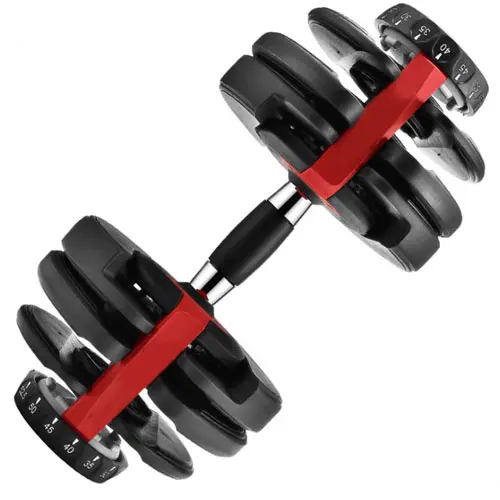
Strength training with dumbbells offers a wide range of benefits, making them a versatile and effective tool for building muscle, improving joint stability, and increasing overall functional strength. Dumbbells are ideal for targeting specific muscle groups, enhancing coordination, and correcting imbalances between sides of the body. Whether you are a beginner or an advanced lifter, dumbbells can be adapted to suit any workout routine. In this section, we’ll explore the numerous advantages of incorporating dumbbells into your strength training regimen, from their ability to work stabilizing muscles to their convenience in offering progressive overload.
Targeting Unilateral Training and Correcting Muscle Imbalances
One of the key benefits of using dumbbells is their ability to facilitate unilateral training, which involves working one side of the body at a time. This is important for correcting muscle imbalances, where one side may be weaker or less developed than the other. By performing exercises like single-arm rows or lunges with dumbbells, you can ensure both sides of your body are equally engaged, promoting balanced muscle growth. This also improves overall coordination and can help prevent injury caused by muscle asymmetry.
Dumbbells are excellent for engaging stabilizing muscles that often go unnoticed during machine-based exercises. When using dumbbells, your body must activate smaller stabilizer muscles to maintain control of the weights, which leads to greater joint stability. For example, during exercises like dumbbell bench presses or shoulder presses, your core and shoulder stabilizers work hard to ensure proper form and control throughout the movement. This not only strengthens the muscles around your joints but also enhances functional strength, improving your ability to perform everyday tasks. Dumbbells offer remarkable versatility in strength training. They can be used for a wide range of exercises targeting nearly every muscle group, from the legs and back to the arms and shoulders. Whether you’re doing compound movements like squats and deadlifts or isolation exercises like bicep curls and tricep extensions, dumbbells allow for a diverse workout routine. Additionally, their portability makes them suitable for any gym workouts, ensuring you have access to a full-body training routine wherever you go. Another significant benefit of using dumbbells is their ability to facilitate progressive overload, which is essential for muscle growth. As you get stronger, you can gradually increase the weight of your dumbbells to continue challenging your muscles. Many dumbbells are designed to be adjustable, meaning you can increase the weight incrementally without needing a complete set of new equipment. This adaptability makes dumbbells a great investment for those looking to progress at their own pace while maximizing strength and muscle development. Unlike machines that often isolate specific movements, dumbbells mimic the natural movement patterns of everyday activities, improving functional strength. By incorporating dumbbells into your routine, you train muscles to work together in a coordinated manner, which helps improve balance, posture, and overall athleticism. This type of strength is crucial for improving performance in sports, as well as enhancing your ability to perform daily tasks, like lifting groceries or carrying heavy objects. Incorporating dumbbells into your strength training routine provides a host of benefits, from improving muscle imbalances and stabilizing joints to offering versatility and supporting progressive overload. With their wide range of applications and ability to enhance functional strength, dumbbells are a powerful tool for anyone looking to improve their overall fitness and strength training outcomes. Engaging Stabilizing Muscles for Joint Stability
Versatility and Variety in Strength Training
Progressive Overload and Adaptability
Improving Functional Strength
Best Weight Range for Dumbbells for Beginners
Choosing the right weight range for dumbbells as a beginner can significantly impact your workout success. It ensures proper form, reduces the risk of injury, and sets you up for sustainable progress. This guide explores multiple aspects of selecting the ideal dumbbell weight, taking into account exercise goals, gender, fitness levels, and different workout types. By considering these factors, you can tailor your approach to match your unique needs.
The Importance of Starting Light
Starting light is crucial for mastering proper technique and avoiding injury. As a beginner, you may be unfamiliar with specific exercises, so lighter dumbbells allow you to focus on form rather than lifting heavy loads. Most beginners benefit from starting with 1-5 kg (2-10 lbs) for upper-body exercises like bicep curls or shoulder presses and 4-10 kg (10-20 lbs) for lower-body movements like squats or deadlifts. Starting light also reduces the likelihood of overtraining and muscle strain.
Men and women may have different starting points due to natural variations in muscle mass and strength. On average, women may begin with 1-3 kg (2-7 lbs) dumbbells for upper-body workouts and 3-5 kg (7-12 lbs) for lower-body exercises. Men, who typically have greater muscle mass, might start with 4-8 kg (10-20 lbs) for upper-body exercises and 6-10 kg (15-25 lbs) for lower-body movements. Regardless of gender, fitness levels play a significant role. If you’re completely new to resistance training, always err on the lighter side. Weight ranges based on whether you want to build strength, tone, or improve endurance. Investing in adjustable dumbbells offers a versatile solution for beginners. These allow you to start with lighter weights and gradually increase resistance as you gain strength. Adjustable dumbbells typically range from 1-25 kg (2-55 lbs), catering to various exercises and fitness levels. This flexibility eliminates the need to buy multiple sets, making them both space-efficient and cost-effective. How to find your ideal starting weight through practical testing. The best way to choose the correct weight is by testing. Pick a dumbbell and perform 8-12 repetitions of an exercise. If the last few reps feel challenging but manageable, you’ve found the right weight. If the dumbbell feels too easy or you can’t complete your reps with proper form, adjust accordingly. This trial-and-error approach ensures your dumbbell selection matches your current strength and goals. Selecting the best weight range for dumbbells as a beginner involves understanding your fitness level, goals, and exercise types. Starting light, considering adjustable options, and testing your limits are key steps to finding the perfect range. A thoughtful approach helps build confidence, avoids injury, and sets you on a path to progress with your dumbbell training journey. Gender and General Fitness Levels
Different Dumbbell Weights for Various Goals
Adjustable Dumbbells: A Flexible Solution
Testing the Right Dumbbell Weight
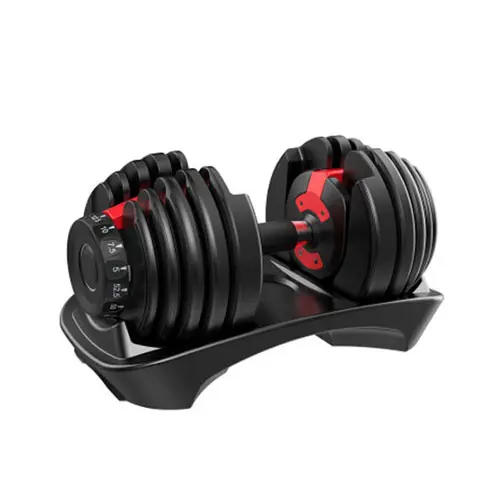
How Wide is the Handle of a Dumbbell?
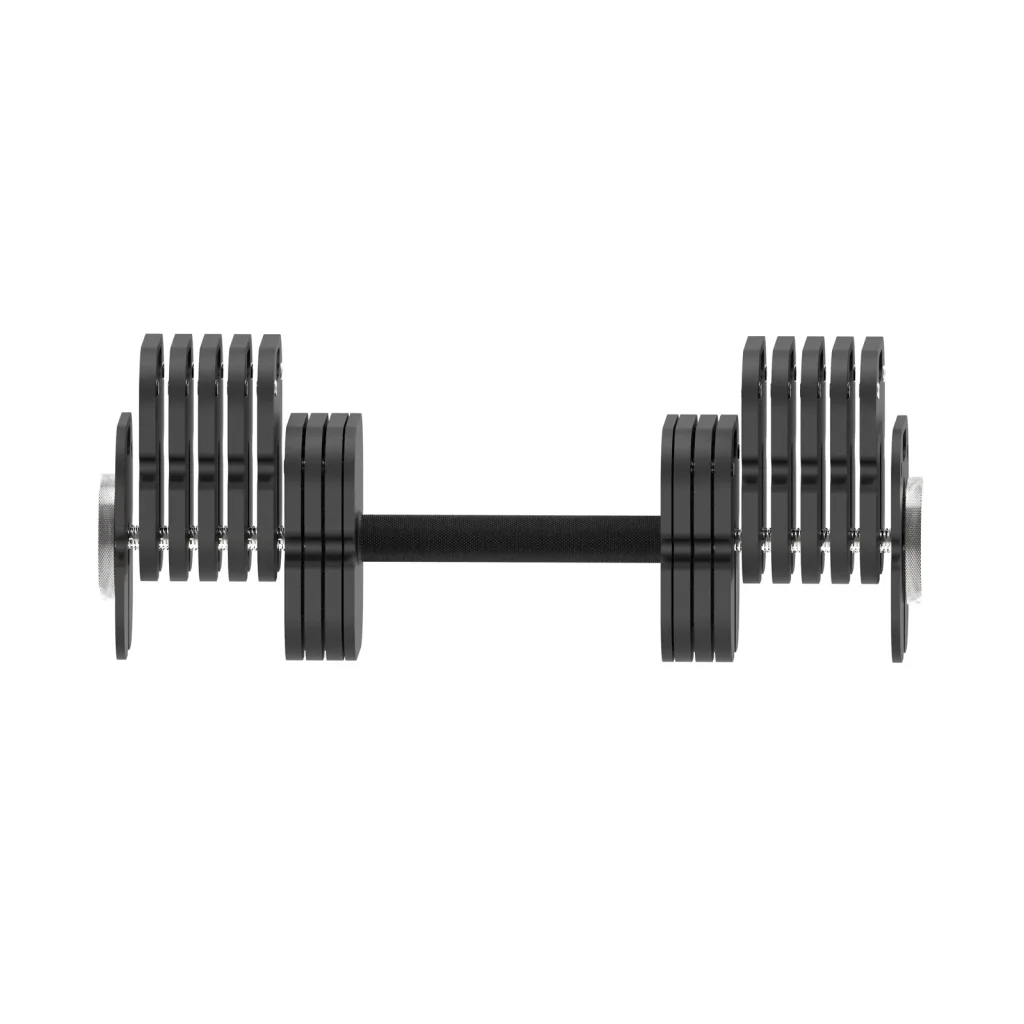
The width of a dumbbell handle is an important factor that can influence your grip, comfort, and overall training experience. Handle width can vary based on the type of dumbbell, its design, and its intended use. A wider or narrower handle can change how the weight is distributed in your hand, affecting both your workout performance and the potential for injury prevention. In this section, we will explore the different aspects of dumbbell handle width, including the factors that affect it, the ideal width for comfort and grip, and how it can impact various types of exercises.
Factors That Affect Dumbbell Handle Width
Dumbbell handle width can vary depending on the design of the dumbbell and its intended purpose. For example, adjustable dumbbells often feature wider handles compared to fixed-weight dumbbells, as they are designed to accommodate the extra space needed for the adjustment mechanism. On the other hand, rubber-coated or neoprene dumbbells may have slightly thinner handles, as they are typically used for lighter weights and are designed for easier grip and portability. The material of the handle can also play a role in the perceived width; metal handles may feel thinner or thicker depending on the coating or texture.
The ideal handle width for a dumbbell depends on the size of your hands and the exercises you plan to perform. Most standard dumbbells have handles that are about 1 to 1.5 inches in diameter, which provides a good balance of comfort and grip for most users. However, individuals with larger hands may find that a wider handle (around 1.75 to 2 inches) offers better control and reduces hand fatigue during longer sets. Conversely, those with smaller hands may prefer a narrower handle, as it allows for a more secure grip and reduces strain on the fingers and wrists. The width of the handle can have a significant impact on your grip strength and overall performance during strength training exercises. A handle that is too wide can lead to grip slippage, making exercises like dumbbell rows or curls more challenging and potentially causing your form to suffer. Conversely, a handle that is too narrow may feel uncomfortable and cause unnecessary strain on your hands and wrists. When selecting dumbbells, it’s important to consider the type of exercise you’ll be doing and how the handle width may affect your ability to maintain a firm, controlled grip. For exercises that require heavy lifting or dynamic movement, a slightly thicker handle may provide better stability. The width of a dumbbell handle also plays a role in ensuring safe lifting practices. If the handle is too thin, it may be harder to maintain control of the weight, especially when performing high-intensity or rapid exercises. This could increase the risk of injury, as you may not be able to secure the dumbbell properly. On the other hand, a handle that is too wide might create unnecessary strain on your wrists, elbows, or shoulders. Ideally, the handle should provide a firm yet comfortable grip, ensuring you can maintain control of the dumbbell without straining the joints or muscles. Different types of dumbbells offer variations in handle width to suit various workout preferences. For example, traditional metal dumbbells typically have narrower handles (1 to 1.5 inches), while rubber-coated or neoprene versions often feature slightly wider handles to provide additional comfort. Adjustable dumbbells feature wider handles to accommodate the locking mechanisms and weight adjustments. In commercial gyms, you’ll often find dumbbells with a variety of handle widths, ensuring there is an option that suits all users. The width of a dumbbell handle plays a crucial role in your comfort, grip, and overall performance during strength training. Factors like hand size, exercise type, and safety considerations should guide your choice of dumbbell handle width. Understanding how handle width affects your grip and training experience will help you select the right dumbbells for your needs and ensure a more effective and safe workout. Ideal Handle Width for Comfort and Grip
How Handle Width Affects Grip Strength and Performance
Handle Width and Safety Considerations
Variations Based on Dumbbell Type
Key Factors to Consider When Customizing Dumbbells
Customizing dumbbells involves tailoring their design, features, and functionality to suit your specific workout needs, preferences, and fitness goals. This allows you to create a more personalized workout experience that aligns with your training style. From material and adjustability to grip and weight range, each aspect plays a critical role in achieving optimal results. Below, we explore the essential factors to pay attention to when customizing dumbbells, providing you with a layered understanding of the process.
Material and Durability
Why the choice of material is vital for longevity and performance. The material of your customized dumbbells impacts their durability, comfort, and usability. Steel or cast iron dumbbells are robust and long-lasting but can be noisy and prone to rust if not maintained. Rubber-coated dumbbells are more floor-friendly, reduce noise, and are less prone to damage, making them ideal for any gyms. Vinyl-coated dumbbells are lightweight and affordable but may wear out faster. Choose a material that matches your workout environment and usage frequency.
The importance of flexibility in meeting various workout needs. Customizable dumbbells should provide a wide weight range to cater to different exercises and fitness levels. Adjustable dumbbells are an excellent option, allowing you to modify the weight in small increments without purchasing multiple sets. For example, adjustable dumbbells with ranges from 2-25 kg (5-55 lbs) are ideal for beginners and advanced users. Ensure the mechanism for changing weights is sturdy and easy to use to avoid interruptions during your workout. How grip comfort affects performance and safety. The grip and handle design of your dumbbells significantly affect your training experience. Look for textured or knurled handles that provide a secure grip, especially during sweaty or intense workouts. Additionally, ensure the handle diameter is appropriate for your hand size; oversized handles can cause discomfort and reduce control. Ergonomic designs with non-slip features add to safety and comfort. Why aesthetics and personalization can enhance your motivation. Customizing the appearance of your dumbbells, such as choosing specific colors, patterns, or adding your logo, can make your equipment more appealing. This personalization not only reflects your style but can also boost motivation and pride in using your custom gym gear. However, ensure that these aesthetic choices do not compromise the functionality or durability of the dumbbells. Balancing quality and affordability when customizing dumbbells. Customizing dumbbells can be an investment, so setting a budget is essential. Prioritize functionality and durability over aesthetic extras to ensure value for money. Adjustable dumbbells, though initially more expensive, offer cost efficiency over time by eliminating the need for multiple sets. Compare manufacturers and seek reliable brands that provide warranties for their products. Planning for practicality in your workout space. If you have limited space, consider compact designs or adjustable dumbbells that save room. Customizing a dumbbell rack can also be an efficient solution to organize your equipment. Make sure your custom setup aligns with the dimensions of your workout area for easy access and storage. When customizing dumbbells, it’s important to focus on materials, adjustability, grip, and your budget to ensure they meet your needs. Personalizing your equipment with aesthetics and branding can enhance motivation, but functionality and durability should always take priority. By considering these factors, you can create dumbbells that perfectly align with your fitness journey and maximize your workout efficiency. Adjustability and Weight Range
Grip and Handle Design
Aesthetic and Custom Branding
Budget and Cost Efficiency
Space and Storage Requirements
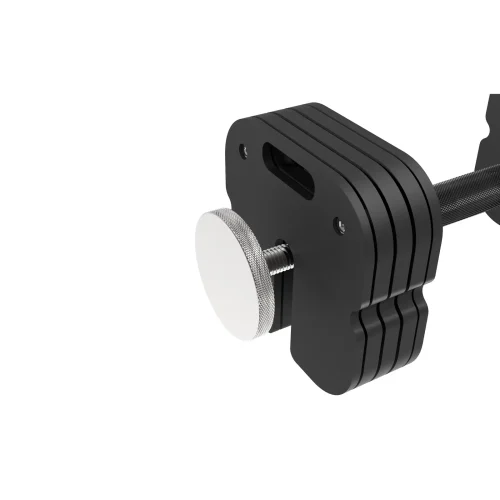
How to Maintain Dumbbells to Ensure Their Service Life

Maintaining your dumbbells is essential for ensuring their longevity and keeping them in optimal condition for your strength training sessions. Whether you’re using metal, rubber-coated, neoprene, or adjustable dumbbells, regular care can help prevent wear and tear, protect the materials, and keep them functioning like new. Proper storage, cleaning, and occasional inspections will go a long way in preserving the quality and lifespan of your dumbbells. In this guide, we will explore several key maintenance practices that can help extend the service life of your dumbbells, including cleaning techniques, safe storage methods, and tips to avoid damage.
Regular Cleaning to Maintain Appearance and Functionality
One of the most important aspects of dumbbell maintenance is keeping them clean. Dirt, sweat, and grime can build up on the handles and weight plates, leading to discomfort during workouts and even potential damage to the materials over time. For metal or rubber-coated dumbbells, use a damp cloth with mild soap to wipe down the surface after each use. Avoid using harsh chemicals or abrasive sponges, as they can damage the finish. For neoprene or vinyl dumbbells, a soft cloth and warm water are typically sufficient. Regular cleaning prevents rust buildup on metal dumbbells and keeps the handles from becoming slippery due to grime or oils.
Storing your dumbbells properly is crucial for maintaining their integrity. Dumbbells should be stored in a cool, dry place, away from direct sunlight and moisture, as exposure to these elements can cause rust or deterioration over time. For metal dumbbells, always store them on a dumbbell rack to prevent them from being dropped or knocked around. Rubber-coated and neoprene dumbbells should also be stored off the ground to protect their coatings from dirt and damage. If you’re using adjustable dumbbells, ensure they are placed securely on their stand to avoid any shifting or damage to the adjustment mechanisms. Proper storage helps preserve the quality of the dumbbells, especially when they’re not in use. While dumbbells are designed to withstand a fair amount of use, repeatedly dropping them can cause significant wear and tear, particularly on rubber-coated or neoprene versions. Dropping dumbbells onto hard surfaces can damage the coating, create dents, or cause internal mechanisms (in adjustable dumbbells) to malfunction. To prevent this, always use a mat or protective flooring when performing exercises that involve dropping or setting down dumbbells. Additionally, practice controlled movements and ensure you don’t let the dumbbells slip out of your grip during exercises like deadlifts, cleans, or snatches. This will help protect both the dumbbells and the floor from unnecessary damage. Even with regular care, it’s essential to inspect your dumbbells periodically for signs of wear and tear. Check the handles for any loose bolts or wobbling, as well as any cracks or damage to the rubber or neoprene coatings. For adjustable dumbbells, ensure the locking mechanisms are functioning correctly and that the weights are securely fastened before each use. If you notice any signs of damage, such as rust on metal plates or loose parts, it’s best to address the issue right away to avoid potential safety hazards during your workout. Regular inspections allow you to catch problems early, extending the life of your dumbbells and keeping you safe. Moisture can be a major enemy to your dumbbells, particularly those made of metal. Exposure to humidity, sweat, or water can cause rust to form, which can degrade the material and potentially weaken the structure of the dumbbells over time. After use, always ensure that your dumbbells are dried thoroughly, especially if you’re working out in a humid environment. For metal dumbbells, consider using a rust-resistant spray to protect the surface. If you notice any rust spots, use a fine sandpaper or steel wool to gently remove them and prevent further corrosion. Protecting dumbbells from moisture ensures they stay functional and aesthetically pleasing for a longer period. Adjustable dumbbells require a bit more attention due to their moving parts and weight adjustment mechanisms. Regularly check the locking mechanisms and make sure they are securely fastened when switching weights. If your adjustable dumbbells use a dial or pin system, inspect the tracks for any debris that might cause them to jam. Periodically lubricating the adjustment mechanisms (as recommended by the manufacturer) can also help keep the system running smoothly. Ensuring that the weights are securely attached before each use will prevent any accidental weight shifts during exercises, which could lead to injury. Maintaining your dumbbells through regular cleaning, proper storage, and inspections is essential for ensuring they last for many years of use. By following these simple maintenance practices, you can protect your investment, preserve the functionality of your dumbbells, and enjoy a safe and effective strength training routine. Proper Storage to Prevent Damage
Avoiding Impact and Drop Damage
Inspecting Dumbbells for Wear and Tear
Protecting Dumbbells from Moisture and Rust
Regular Maintenance for Adjustable Dumbbells
FAQs about Dumbbells
Why Are Dumbbells So Expensive?
Dumbbells can vary significantly in price based on several factors. One of the main reasons for the high cost is the material used in their construction. For instance, premium dumbbells made from high-quality materials like cast iron or rubber-coated options tend to be more expensive than their plastic or cement counterparts. Additionally, the manufacturing process can also contribute to the price. High-end brands often invest in better production techniques, resulting in a higher-quality product that can withstand regular use.
Another factor influencing the price is the type of dumbbell. Adjustable dumbbells, which allow users to change weights, often carry a higher price tag due to their versatility and convenience. The demand for fitness equipment has surged in recent years, especially during the pandemic, causing prices to rise due to increased demand and supply chain challenges. Lastly, brand reputation plays a role; well-known fitness brands may charge more due to their established credibility and perceived quality.
What Weight Is Best for Dumbbells?
The ideal weight for dumbbells largely depends on the individual’s fitness level and specific goals. Beginners may find that starting with lighter weights, such as 5 to 10 pounds, is beneficial for learning proper form and technique without risking injury. For those focusing on toning and endurance, moderate weights ranging from 10 to 20 pounds may be appropriate, allowing for higher repetitions while still challenging the muscles.
More experienced lifters aiming to build strength might opt for heavier weights, generally starting around 20 pounds and increasing as their strength improves. It’s crucial to choose a weight that allows you to perform exercises with proper form for the desired number of repetitions. If you can easily complete your sets, it may be time to increase the weight. A good practice is to have a variety of dumbbells on hand to accommodate different exercises and ensure progressive overload.
Can You Build Muscle with Just Dumbbells?
Yes, you can effectively build muscle using just dumbbells! While many people associate muscle building with heavy barbells or weight machines, dumbbells offer a versatile and efficient way to engage various muscle groups. Dumbbells enable a greater range of motion compared to fixed machines, which can lead to improved muscle activation and growth.
To build muscle with dumbbells, focus on progressive overload—gradually increasing the weight or the number of repetitions over time. Compound exercises like dumbbell squats, lunges, and presses are particularly effective as they target multiple muscle groups simultaneously, promoting overall muscle growth. It’s essential to follow a well-structured workout program that includes sufficient volume and intensity, as well as adequate recovery time, to allow muscles to repair and grow.
Which type of dumbbell is best?
The best type of dumbbell depends on your goals, preferences, and workout space. Fixed dumbbells are a great choice for durability and ease of use, especially if you have space for a rack. Adjustable dumbbells are perfect for saving space and provide a range of weights in one set. Rubber-coated dumbbells are popular for their durability, quietness, and safety, as they won’t damage floors if dropped. Metal dumbbells are long-lasting but can be slippery if your hands get sweaty. Neoprene or vinyl dumbbells are lighter and often more colorful, making them excellent for beginners, rehabilitation exercises, or aerobic workouts. Consider the type of exercises you’ll perform, your storage capacity, and budget when selecting dumbbells. For versatile strength training, adjustable or rubber-coated dumbbells are often the best choice.
How heavy should beginner dumbbells be?
Beginners should start with dumbbells that are challenging but manageable for their strength level. For most people, this means selecting weights between 5 and 15 pounds. Women often start with 5- to 10-pound dumbbells, while men may begin with 10- to 15-pound ones. The goal is to pick a weight that allows you to perform 12 to 15 repetitions of an exercise with proper form but feels challenging by the last few reps. If the weight feels too easy, you won’t see much progress, and if it’s too heavy, it increases the risk of injury. Start with lighter weights for exercises that target smaller muscle groups, such as bicep curls, and slightly heavier ones for compound movements like squats or deadlifts. As you build strength, you can gradually increase the weight to continue challenging your muscles.
Are 20-pound dumbbells enough to build muscle?
Yes, 20-pound dumbbells can build muscle, especially for beginners and intermediate lifters. Muscle growth depends more on how you use the weights than their absolute weight. If 20 pounds feels heavy enough to challenge you for 8 to 12 repetitions of a particular exercise, you can stimulate muscle growth. For advanced lifters, 20-pound dumbbells might not be sufficient for larger muscle groups like the chest, back, or legs, but they can still be effective for isolation exercises, high-rep sets, or techniques like supersets. Progressive overload is key to muscle building, so you’ll eventually need heavier weights as you get stronger. Pairing 20-pound dumbbells with proper form, a variety of exercises, and consistent training can help you achieve noticeable muscle growth, but you may need to upgrade over time to continue progressing.
Are dumbbells better than bodyweight?
Dumbbells and bodyweight exercises both offer unique benefits, and one isn’t universally better than the other. Dumbbells provide more flexibility to target specific muscle groups with a wide range of movements. They also allow for progressive overload by increasing weight, which is crucial for building strength and muscle over time. Bodyweight exercises, on the other hand, are excellent for functional fitness, improving balance, and working multiple muscle groups simultaneously. They’re also convenient, requiring no equipment and often engaging stabilizing muscles more effectively. Dumbbells might be better for building muscle in targeted areas, while bodyweight exercises excel at improving overall body control and endurance. Combining both in a workout program can provide a well-rounded fitness routine. For instance, you might use dumbbells for strength and muscle-building and bodyweight moves for agility, flexibility, and endurance.
Are lighter or heavier dumbbells better?
Lighter and heavier dumbbells serve different purposes, and the best choice depends on your fitness goals. Lighter dumbbells are ideal for endurance training, high-repetition exercises, and activities like aerobics or rehabilitation. They’re also great for beginners learning proper form. Heavier dumbbells are more effective for building strength and muscle through lower-rep, high-intensity exercises. For maximum results, a balanced approach is often best: use lighter weights for smaller muscles or dynamic movements and heavier weights for compound lifts like squats, deadlifts, or bench presses. To make progress, the key is choosing a weight that challenges you without sacrificing form. Whether you go lighter or heavier, focus on progressive overload—gradually increasing weight or reps over time—to continue improving strength, muscle mass, or endurance.
Are metal or rubber dumbbells better?
Rubber dumbbells are generally better for gyms due to their durability and floor protection. They’re less likely to cause damage if dropped and tend to be quieter when placed down, making them more practical for residential spaces. Metal dumbbells, while highly durable, can be slippery and noisy. They may also damage floors if not used on a protective mat. For gym environments, metal dumbbells might be more common, but rubber dumbbells are often preferred for safety and comfort. Aesthetics and feel may also play a role; some lifters prefer the raw feel of metal dumbbells. Ultimately, the decision depends on your priorities—opt for rubber-coated dumbbells if noise and floor safety are concerns, but metal ones can be a solid choice for durability and simplicity.
Are neoprene or vinyl dumbbells better?
Neoprene and vinyl dumbbells are both popular for light to moderate-weight options, but neoprene dumbbells typically have the edge in terms of grip and durability. Neoprene offers a soft, textured surface that provides a non-slip grip, even when your hands are sweaty. They’re also less prone to cracking compared to vinyl. Vinyl dumbbells have a smoother surface, which might feel less secure during workouts, especially if you’re perspiring. Both types are excellent for beginners, group fitness classes, or rehabilitation exercises, and they often come in bright, attractive colors. Neoprene dumbbells are generally more durable and versatile, while vinyl dumbbells tend to be slightly more affordable. For long-term use and better grip, neoprene is often the better choice.
Can dumbbells reduce belly fat?
Dumbbells can contribute to reducing belly fat, but they aren’t a magic solution. Belly fat loss requires a combination of regular exercise, a balanced diet, and a calorie deficit. Dumbbell exercises can help by building muscle, which increases your resting metabolic rate, enabling you to burn more calories throughout the day. Incorporating full-body dumbbell workouts, such as circuits or compound movements like squats and presses, can burn calories and boost fat loss. Pair these with cardiovascular activities like running or cycling for the best results. It’s important to note that fat loss can’t be targeted to a specific area, so you’ll need to focus on overall body fat reduction. When combined with healthy eating and consistent exercise, dumbbell workouts can play a key role in achieving a leaner physique.
Can you build muscle with 10-pound weights?
You can build muscle with 10-pound weights, but it may depend on your starting fitness level. For beginners or those recovering from an injury, 10-pound dumbbells can be enough to challenge the muscles and stimulate growth. To maximize effectiveness, focus on higher repetitions, slow and controlled movements, and techniques like supersets or isometric holds. Over time, however, your muscles will adapt, and 10-pound weights may no longer provide sufficient resistance for continued growth. In such cases, consider progressing to heavier weights or incorporating other methods to challenge your muscles, such as increasing the number of reps, sets, or exercise intensity. While 10-pound weights can be effective for certain exercises and fitness levels, gradually increasing resistance is essential for long-term muscle-building success.
Does it matter what dumbbells you use?
Yes, the type of dumbbells you use can make a difference depending on your goals, preferences, and workout environment. For instance, adjustable dumbbells are great for versatility and space-saving, while fixed dumbbells are more convenient for quick transitions between exercises. Rubber-coated dumbbells are ideal for protecting floors and reducing noise, making them suitable for gyms. In contrast, metal dumbbells are highly durable and often preferred in commercial gyms. Lighter neoprene or vinyl dumbbells work well for beginners, aerobic exercises, or physical therapy, while heavier dumbbells are better for strength and muscle-building. The grip, shape, and feel of the dumbbell can also impact comfort and performance. Ultimately, the right choice depends on your fitness goals, budget, and workout setup. Investing in high-quality, comfortable dumbbells that suit your needs can enhance your training experience and results.
How do I choose the right dumbbell weight?
Choosing the right dumbbell weight depends on your fitness level, goals, and the exercise you’re performing. Beginners should start with light weights, typically 2-5 kg (5-10 lbs), to focus on form and prevent injury. For strength training, select a weight that challenges you to complete 8-12 reps with proper form. If you’re doing endurance or toning exercises, lighter weights with higher reps work better. Test the weight by performing a few reps; it should feel challenging by the final few reps without compromising your form. For compound movements like squats, heavier weights may be appropriate, whereas isolation exercises, like bicep curls, often require lighter weights. Adjust weights as your strength improves.
How many dumbbell reps per day?
The number of reps you should do with dumbbells depends on your goals. For muscle building, aim for 6-12 reps per set. For muscular endurance, go for 12-20 reps. Typically, completing 3-4 sets of an exercise 2-4 times per week is sufficient for most people. Overworking your muscles daily can lead to fatigue and injury, so give yourself rest days for recovery. Beginners might benefit from starting with 8-12 reps per set of 2-3 exercises targeting different muscle groups. Keep track of your progress, and as you grow stronger, increase reps or weights gradually.
How many sets of dumbbells should I do as a beginner?
As a beginner, you should aim to perform 2-3 sets of each exercise. Choose 3-4 exercises per workout that target different muscle groups, such as squats for legs, rows for back, and shoulder presses for shoulders. Rest for 30-60 seconds between sets to recover. Focus on perfecting your form rather than lifting heavy weights. As you build strength and endurance, you can increase to 3-4 sets per exercise or add more exercises to your routine. Remember, consistency is key, and progressing gradually reduces the risk of injury.
How to get a V-shaped body with dumbbells?
To develop a V-shaped body, focus on exercises that build the lats, shoulders, and upper back while keeping the waist toned. Dumbbell rows, lateral raises, and shoulder presses are excellent for widening your upper body. Incorporate planks or Russian twists with a dumbbell to sculpt your core and keep your waist tight. Aim for 8-12 reps per set with progressive overload (increasing weights over time). Consistency, combined with a calorie-controlled diet to reduce body fat, is essential to achieve the V-shape.
Is it better to have 2 dumbbells or 1?
Using two dumbbells provides a balanced workout as it works both sides of the body equally, reducing muscle imbalances. Exercises like dumbbell presses, curls, and rows are typically more effective with two dumbbells. A single dumbbell is versatile and useful for unilateral exercises like single-arm rows or goblet squats, focusing on core stability. If you’re on a budget, one dumbbell can suffice for many exercises, but having two allows for more variety and balanced strength development.
What are the disadvantages of dumbbells?
While dumbbells are highly versatile, they have a few disadvantages. First, they can be bulky or cumbersome for some exercises, such as chest flys, where you need to balance heavy weights. Secondly, progressive overload can become expensive since you may need to purchase multiple sets as you grow stronger. Fixed-weight dumbbells can also take up significant space. Lastly, improper form, especially when lifting heavy weights, can lead to injury, making it crucial to prioritize technique.
What are the disadvantages of hex dumbbells?
Hex dumbbells, while practical, have a few downsides. Their hard edges can be uncomfortable during certain exercises, such as goblet squats or dumbbell push-ups, where the dumbbell directly contacts your skin. Some hex dumbbells are made of cheaper materials like cast iron, which can chip or rust over time. Additionally, fixed-weight hex dumbbells require purchasing multiple sets as your strength increases, which can be expensive and space-consuming.
What is the best dumbbell weight for building muscle?
The ideal dumbbell weight for building muscle allows you to perform 6-12 reps with proper form. For most people, this ranges between 10-50 lbs, depending on the muscle group and exercise. Compound exercises like dumbbell bench presses require heavier weights, while isolation moves like lateral raises need lighter weights. Gradually increase weight as your strength improves to continue challenging your muscles.
Which material of dumbbell is best?
The best material depends on your preferences and needs. Rubber-coated dumbbells are durable, protect your floors, and are quieter when dropped. Steel dumbbells are long-lasting but can be prone to rust if not maintained. Vinyl dumbbells are budget-friendly and great for beginners but may wear out over time. Choose the material based on your budget, environment, and workout intensity.
Why are hex dumbbells cheaper?
Hex dumbbells are cheaper because they’re made with simple materials like cast iron or rubber, and their manufacturing process is less complex than adjustable dumbbells. Their fixed-weight design and lack of advanced features like grip adjustability or compact storage also contribute to lower costs. Additionally, hex dumbbells’ basic design makes them easier and less expensive to produce in bulk.
